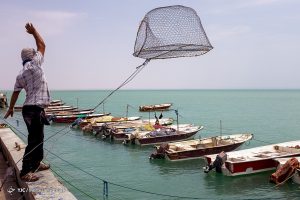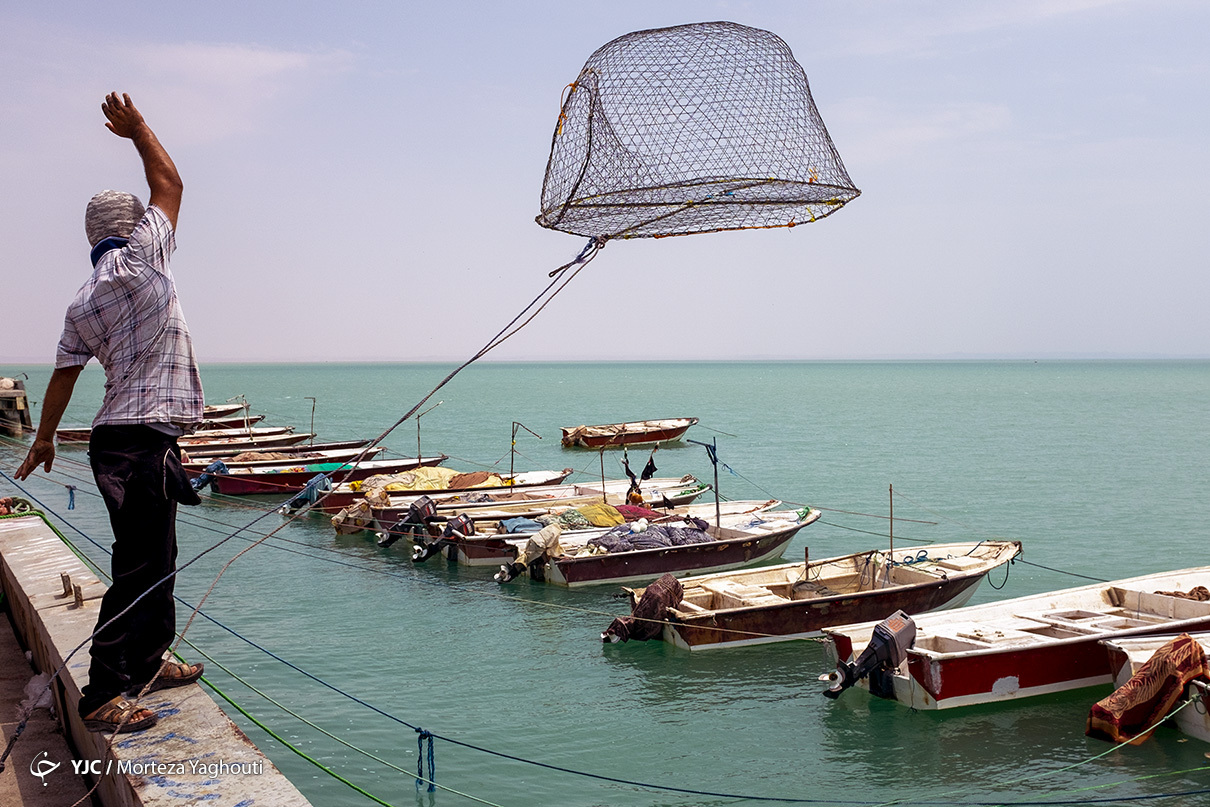Explore how sustainable fisheries management in the Persian Gulf is reshaping marine conservation and coastal livelihoods. Learn about strategies, challenges, and innovations that support regional food security and biodiversity.

Bahrakan; The Biggest Fishing Port of Iran. Credit: https://ifpnews.com/bahrakan-the-biggest-fishing-port-of-iran/
Why Sustainable Fisheries Management Matters in the Persian Gulf
Fishing is more than a livelihood in the Persian Gulf—it’s a cultural identity, a source of food security, and a critical part of regional economies. From the bustling fish markets of Kuwait to the traditional dhow fleets of Oman, the Gulf’s fisheries have supported communities for thousands of years.
But over the past few decades, this vital resource has come under serious strain. Overfishing, pollution, habitat degradation, climate change, and unregulated trawling have led to declining fish stocks and threatened marine biodiversity. According to the Food and Agriculture Organization (FAO), several commercially important species in the Gulf—such as hamour (grouper), kingfish, and shrimp—are now either overexploited or at risk of collapse.
In a region where coastal nations rely on seafood as a primary protein source and where climate variability is increasing, sustainable fisheries management is no longer optional. It is a necessity for economic resilience, environmental protection, and maritime sustainability.
Understanding the Gulf’s Fisheries and Marine Ecosystem
Ecological Significance
The Persian Gulf’s warm, shallow waters—averaging only 35 meters in depth—host over 700 species of fish, alongside important marine habitats like:
-
Seagrass beds (nurseries for juvenile fish)
-
Mangroves (important for shoreline protection and biodiversity)
-
Coral reefs (supporting complex ecosystems)
These ecosystems are interconnected, and the health of fish stocks directly reflects the condition of the surrounding marine environment.
Socioeconomic Role
Fishing supports tens of thousands of livelihoods in Gulf states. In Oman, for instance, the fishing industry employs nearly 50,000 people and contributes more than USD 1 billion to the national economy annually. In the UAE, while fisheries contribute less to GDP, they are crucial to heritage and food sovereignty goals under Vision 2030.
Traditional fishing methods such as handlines, traps, and gillnets are still common—but increasingly threatened by industrial-scale practices.
Major Threats to Sustainable Fisheries in the Persian Gulf
Overfishing and Illegal, Unreported, and Unregulated (IUU) Fishing
Uncontrolled fishing is the most immediate threat. As per the UNEP’s Regional Seas Report, up to 85% of commercial fish stocks in the Gulf are fully exploited or overexploited.
IUU fishing, often conducted by vessels without licenses or using banned methods like bottom trawling, exacerbates the problem. Iran’s southern coast and parts of Iraq and Bahrain are hotspots, where enforcement resources remain stretched.
Habitat Loss and Coastal Development
Dredging, land reclamation, and pollution from port construction and oil infrastructure have led to the destruction of vital breeding grounds.
For example, the expansion of Khalifa Port in Abu Dhabi and Hamad Port in Qatar disrupted seagrass and coral habitats. According to a 2021 Marine Pollution Bulletin study, local fish populations dropped by 25–30% in areas adjacent to construction zones.
Climate Change and Ocean Warming
Rising sea temperatures and increasing salinity levels, exacerbated by desalination plants, are causing:
-
Shifts in fish migration patterns
-
Coral bleaching (affecting reef-dependent fish)
-
Reduced reproductive success in species like anchovies and sardines
The World Bank (2023) warns that climate-induced stress could reduce Gulf fishery productivity by up to 30% by 2050 if no adaptive action is taken.
Key Strategies for Sustainable Fisheries Management
Science-Based Quotas and Stock Assessments
Effective fisheries management begins with good data. The GCC Statistical Center, in partnership with the FAO, is working on standardizing stock assessments across Gulf nations.
Oman has already implemented total allowable catch (TAC) limits for key species like abalone and shrimp, based on annual surveys and satellite monitoring. These quotas help prevent overexploitation and allow stocks to replenish.
Licensing and Seasonal Fishing Bans
Most Gulf countries now require commercial and traditional fishers to obtain licenses, with varying levels of enforcement.
Seasonal bans are also increasingly common. For instance:
-
UAE bans shark fishing from March to June
-
Saudi Arabia and Bahrain enforce shrimp fishing bans during spawning months
These temporal restrictions, supported by remote vessel monitoring systems (VMS), aim to give breeding populations a chance to recover.
Marine Protected Areas (MPAs)
MPAs help protect habitats critical to fish reproduction and survival. As of 2022, the UAE has 15 MPAs, covering mangroves and coral reefs, while Oman has protected over 4,000 km² of its marine waters.
Yet, implementation across the Gulf is uneven. According to the IUCN, only 5.5% of the Persian Gulf’s marine areas are currently protected, well below the 10% Aichi Biodiversity Target.
Technology and Innovation in Fisheries Management
Smart Monitoring Tools
Gulf states are beginning to invest in tech-enabled monitoring systems. These include:
-
Satellite tracking of fishing vessels via MarineTraffic and Equasis
-
AI-based catch reporting apps, trialed by fisheries cooperatives in Qatar
-
eDNA (environmental DNA) analysis to monitor fish populations from water samples—research underway at KAUST and Qatar University
Such tools reduce reliance on manual inspections and provide near-real-time insights for policymakers.
Sustainable Aquaculture
With wild stocks under pressure, aquaculture has emerged as a key supplement. Saudi Arabia’s National Fisheries Development Program targets 530,000 tonnes of aquaculture production by 2030, focusing on:
-
Sea bream and sea bass farming
-
Shrimp hatcheries in Jizan and Jubail
-
Recirculating aquaculture systems (RAS) for inland farming
However, sustainability remains a concern—especially regarding feed sourcing and water usage. Initiatives by DNV and BIMCO to certify sustainable aquaculture practices are being explored in the region.
Case Studies: Successes and Setbacks
Oman’s Fisheries Reform and Community Involvement
Oman has led the way with:
-
A national fisheries database
-
Community-based management through fisheries cooperatives
-
Implementation of eco-labeling and traceability programs
These reforms, supported by the World Bank’s Sustainable Fisheries Program, have led to a 20% increase in fish biomass in some coastal zones between 2018 and 2023.
Kuwait’s Stock Decline and Limited Enforcement
In contrast, Kuwait continues to struggle with declining stocks, particularly for species like zobaidy (silver pomfret). A 2022 audit noted poor compliance with seasonal bans and limited investment in monitoring systems.
Enforcement remains under-resourced, and illegal fishing by foreign vessels remains an unresolved issue.
Future Outlook: Building a Resilient Fishing Sector
Despite the challenges, the Persian Gulf has the tools to recover its fisheries—if the political will, funding, and scientific collaboration continue to grow.
Emerging trends include:
-
Regional fisheries governance through a GCC Fisheries Council, currently under discussion
-
Climate adaptation plans involving species migration tracking and diversification of catch portfolios
-
Promotion of low-impact fishing gear, supported by FAO-GLOBEFISH partnerships
The Gulf’s sustainable fisheries journey must be tailored to its unique geography and socioeconomic realities. It’s not about copying models from Europe or East Asia—it’s about combining tradition with innovation in a region facing complex environmental challenges.
Frequently Asked Questions (FAQ)
Why are fisheries in the Persian Gulf under threat?
Main threats include overfishing, illegal fishing, habitat destruction, and climate change—leading to declining fish stocks and biodiversity loss.
What species are most affected?
Hamour (grouper), kingfish, shrimp, silver pomfret, and sardines have shown steep declines in population over the past two decades.
What role does climate change play?
Rising sea temperatures and desalination-induced salinity changes disrupt breeding cycles and reduce fish productivity.
Which Gulf country is leading in sustainable fisheries?
Oman is currently the most advanced in data-driven fisheries management and community-based reforms.
Are marine protected areas helping?
Yes, but only 5–6% of the Gulf’s waters are currently protected, well below international targets.
Is aquaculture a good solution?
It can help reduce pressure on wild stocks, but must be managed sustainably to avoid pollution, disease, and habitat conversion.
What are the future strategies being discussed?
Plans include establishing a GCC-wide fisheries council, investing in tech-based monitoring, and expanding sustainable aquaculture.
Conclusion: A Sustainable Catch for the Future
The Persian Gulf’s fisheries are at a crossroads. They reflect the region’s rich maritime heritage—but also its modern challenges. Without sustainable management, the collapse of key fish stocks could have devastating effects on food security, economic diversity, and marine ecosystems.
But the story is not yet over. With bold reforms, community engagement, technology, and regional cooperation, Gulf states can build a fisheries sector that is both productive and sustainable—a model for maritime resilience in arid coastal regions.
For maritime professionals, policymakers, and environmental advocates, sustainable fisheries in the Gulf are not just an environmental issue—they are a test of how tradition, science, and sustainability can shape the oceans of tomorrow.
References
-
Food and Agriculture Organization (FAO). (2022). Status of Marine Fish Stocks in the Persian Gulf. Link
-
Marine Pollution Bulletin. (2021). Impacts of Coastal Development on Persian Gulf Fish Stocks.
-
UNEP Regional Seas Programme. (2023). Marine Biodiversity and Overfishing in the Gulf. Link
-
IUCN. (2022). Marine Protected Areas in West Asia. Link
-
World Bank. (2023). Climate Change and Marine Resources in the Middle East. Link
-
GCC Statistical Center. (2023). Regional Fisheries Management Reports. Link
-
DNV. (2022). Sustainable Aquaculture Certification Programs. Link
-
BIMCO. (2023). Responsible Fisheries and Marine Biodiversity. Link
-
MarineTraffic. (2023). Vessel Monitoring Tools for Fisheries. Link
-
Equasis. (2023). Port Inspection Records and Environmental Reports. Link

